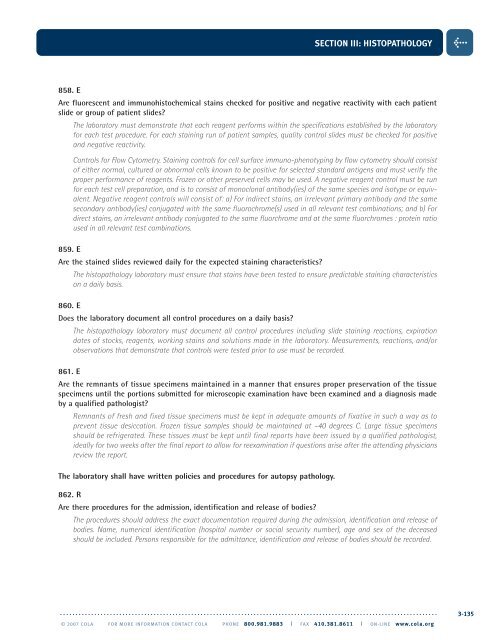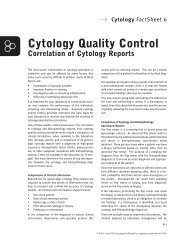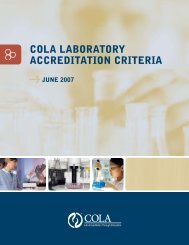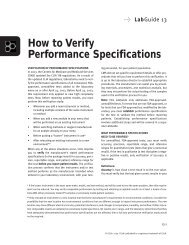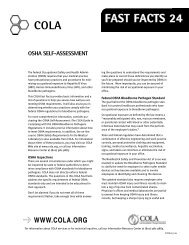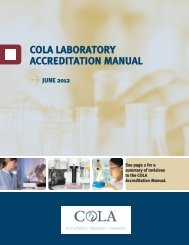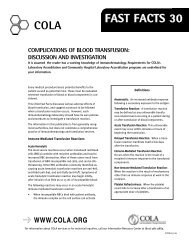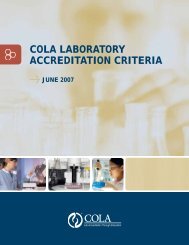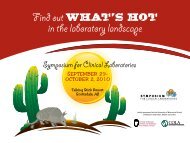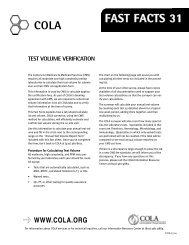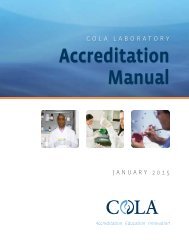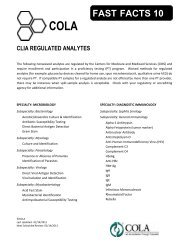Download - COLA
Download - COLA
Download - COLA
- No tags were found...
Create successful ePaper yourself
Turn your PDF publications into a flip-book with our unique Google optimized e-Paper software.
SECTION III: HISTOPATHOLOGY>858. EAre fluorescent and immunohistochemical stains checked for positive and negative reactivity with each patientslide or group of patient slides?The laboratory must demonstrate that each reagent performs within the specifications established by the laboratoryfor each test procedure. For each staining run of patient samples, quality control slides must be checked for positiveand negative reactivity.Controls for Flow Cytometry. Staining controls for cell surface immuno-phenotyping by flow cytometry should consistof either normal, cultured or abnormal cells known to be positive for selected standard antigens and must verify theproper performance of reagents. Frozen or other preserved cells may be used. A negative reagent control must be runfor each test cell preparation, and is to consist of monoclonal antibody(ies) of the same species and isotype or equivalent.Negative reagent controls will consist of: a) For indirect stains, an irrelevant primary antibody and the samesecondary antibody(ies) conjugated with the same fluorochrome(s) used in all relevant test combinations; and b) Fordirect stains, an irrelevant antibody conjugated to the same fluorchrome and at the same fluorchromes : protein ratioused in all relevant test combinations.859. EAre the stained slides reviewed daily for the expected staining characteristics?The histopathology laboratory must ensure that stains have been tested to ensure predictable staining characteristicson a daily basis.860. EDoes the laboratory document all control procedures on a daily basis?The histopathology laboratory must document all control procedures including slide staining reactions, expirationdates of stocks, reagents, working stains and solutions made in the laboratory. Measurements, reactions, and/orobservations that demonstrate that controls were tested prior to use must be recorded.861. EAre the remnants of tissue specimens maintained in a manner that ensures proper preservation of the tissuespecimens until the portions submitted for microscopic examination have been examined and a diagnosis madeby a qualified pathologist?Remnants of fresh and fixed tissue specimens must be kept in adequate amounts of fixative in such a way as toprevent tissue desiccation. Frozen tissue samples should be maintained at –40 degrees C. Large tissue specimensshould be refrigerated. These tissues must be kept until final reports have been issued by a qualified pathologist,ideally for two weeks after the final report to allow for reexamination if questions arise after the attending physiciansreview the report.The laboratory shall have written policies and procedures for autopsy pathology.862. RAre there procedures for the admission, identification and release of bodies?The procedures should address the exact documentation required during the admission, identification and release ofbodies. Name, numerical identification (hospital number or social security number), age and sex of the deceasedshould be included. Persons responsible for the admittance, identification and release of bodies should be recorded.. . . . . . . . . . . . . . . . . . . . . . . . . . . . . . . . . . . . . . . . . . . . . . . . . . . . . . . . . . . . . . . . . . . . . . . . . . . . . . . . . . . . . . . . . . . . . . . . . . . . . . . . . . . . . . . . . . . . . . . . .© 2007 <strong>COLA</strong> FOR MORE INFORMATION CONTACT <strong>COLA</strong> PHONE 800.981.9883 | FAX 410.381.8611 | ON-LINE www.cola.org3-135


